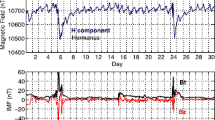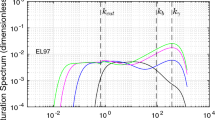Abstract
The approximate theory of ELF propagation in the Earth-ionosphere transmission line described by Booker (1980) is applied to a simplified worldwide model of the D and E regions, and of the Earth's magnetic field. At 1000 Hz by day, reflection is primarily from the gradient on the underside of the D region. At 300 Hz by day, reflection is primarily from the D region at low latitudes, but it is from the E region at high latitudes. Below 100 Hz by day, reflection is primarily from the gradient on the underside of the E region at all latitudes. By night, reflection from the gradient on the topside of the E region is important. There is then a resonant frequency (∼ 300 Hz) at which the optical thickness of the E region for the whistler mode is half a wavelength. At the Schumann resonant frequency in the Earth-ionosphere cavity (∼ 8 Hz) the nocturnal E region is almost completely transparent for the whistler mode and is semi-transparent for the Alfvén mode. Reflection then takes place from the F region. ELF propagation in the Earth-ionosphere transmission line by night is quite dependent on the magnitude of the drop in ionization density between the E and F regions. Nocturnal propagation at ELF therefore depends significantly on an ionospheric feature whose magnitude and variability are not well understood. A comparison is made with results based on the computer program of the United States Naval Ocean Systems Center.
Similar content being viewed by others
References
Banks, P. M. and Kockarts, G.: 1973, Aeronomy, Academic Press, New York.
Barber, N. F. and Crombie, D. D.: 1959, J. Atmos. Terr. Phys. 16, 37.
Barr, R.: 1975, Int. J. Electronics 39, 241.
Barr, R.: 1977, J. Atmos. Terr. Phys. 39, 1379.
Booker, H. G.: 1975, Phil. Trans. Roy. Soc. Lond. A280, 57.
Booker, H. G.: 1977, J. Atmos. Terr. Phys. 39, 619.
Booker, H. G.: 1980, J. Atmos. Terr. Phys. 42, 929.
Booker, H. G. and Dyce, R. B.: 1965, Radio Science 69D, 463.
Greifinger, C. and Greifinger, P.: 1978, Radio Science 13, 831.
Greifinger, C. and Greifinger, P.: 1979, Radio Science 14, 889.
Pappert, R. A. and Moler, W. F.: 1974, Trans. IEEE COM-22, 438.
Pappert, R. A. and Moler, W. F.: 1978, J. Atmos. Terr. Phys. 40, 1031.
Rawer, K., Ramakrishnan, S., and Bilitza, D.: Institüt für Physikalische Weltraumforschung, Scientific Report, W.B. 2.
Rawer, K., Bilitza, D., and Ramakrishnan, S.: 1978a, Rev. Geophys. Space Phys. 16, 177.
Rawer, K., Ramakrishnan, S., and Bilitza, D.: 1978b, International Reference Ionosphere 1978, International Union of Radio Science, Brussels.
Author information
Authors and Affiliations
Additional information
Reprinted from J. Atmos. Terr. Phys. 42.
Rights and permissions
About this article
Cite this article
Behroozi-Toosi, A.B., Booker, H.G. Application of a simplified theory of ELF propagation to a simplified worldwide model of the ionosphere. Space Sci Rev 35, 91–127 (1983). https://doi.org/10.1007/BF00173696
Issue Date:
DOI: https://doi.org/10.1007/BF00173696




